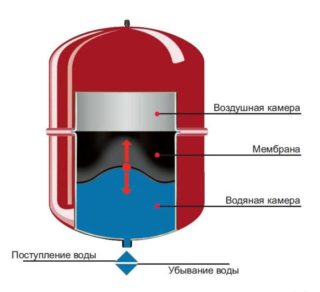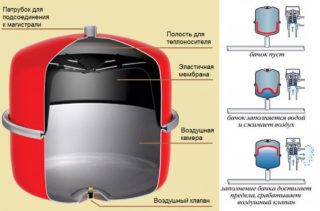There are two tanks on the market that are very similar to each other. This is an expansion tank and a hydraulic accumulator. The question of what is the difference between a hydraulic accumulator and an expansion tank worries many, because their appearance confuses consumers. The purpose of both tanks, as well as design features, are very different.
Purpose of equipment

The expansion tank is used in the heating system of private houses. Its functional duties are to compensate for the expansion of water or other heat carrier. The liquid pumped into the heating of the house, when heated, begins to expand in volume, creating an increased pressure. In order not to break the elements of the network, an expansion tank is installed, where the excess volume of heated water is collected.
A hydraulic accumulator is an element of the plumbing system of a private house. Its functional purpose is to create pressure inside the network when the pumping unit is not working.
The tanks are painted in different colors: the expansion tank is red, the accumulator is blue.
Design features
Outwardly, both tanks differ from each other only in color. They are presented on the market in horizontal and vertical design. As for the internal filling, the fixtures are a steel tank, inside which a membrane is inserted.
Since the expansion tank is used in a hot water system, the diaphragm in it is made of polymers that do not change their technical characteristics when in contact with hot liquids. Manufacturers use EPDM, SBR, butyl rubber and nitrile rubber for this.
In hydroaccumulators, membranes are also used. But they differ in the form of their performance. In these containers, the delimiting material is presented in the form of a pear. In expansion tanks, this is simply a partition that divides the tank into two parts.
The water in the accumulators enters the pear without touching the walls of the steel tank. Here, the starting material for the membrane is food grade rubber.
Principle of operation

The expansion vessel is simple to operate. The coolant, expanding, enters the lower part of the tank, filling it. If the volume of water increases, it presses on the membrane by itself, pushing the latter to the walls of the second upper part of the container. Therefore, it is very important to accurately select the tank in the ratio of its volume to the volume of the coolant located inside the heating system of a private house.
Everything is exactly the same with a water hammer, only several times faster. It is the expansion tank that makes it possible not to fail other elements of the heating system when the coolant heats up quickly.
The accumulator works in almost the same way, but air is pumped into it, or rather, into the space between the rubber bulb and the walls of the tank, under a certain pressure. It creates pressure inside the water supply network. It all happens like this:
- The water pumped in by the pump gets inside the pear.
- The latter expands, squeezing the air injected at the factory.
- The latter presses on the pear, pushing out the water.
The accumulator has two main functions:
- Having a certain volume, it makes it possible for the pump not to turn on when a consumer is opened. As long as the water in the pear is under pressure from the side of the injected air, the pressure inside the water supply system will always be.As soon as the pressure of water and air is equalized, the pumping unit will immediately turn on.
- The accumulator creates a constant and stable pressure inside the pipes of the water supply system. Accordingly, all household appliances, especially washing machines and dishwashers, work flawlessly.
Hydroaccumulators of large volumes, in the range of 50-100 liters, are an additional volume of water that is under pressure all the time. This is convenient in cases where the power supply is turned off and the pump simply cannot pump water. In suburban settlements, this phenomenon is not uncommon.
The hydraulic accumulator, like the expansion tank, well restrains hydraulic shocks of the water supply system, protecting it from breakdowns.
Other distinctive features

The differences between the two devices must be approached from the standpoint of the possibility of replacing them with each other. Here it is necessary to take into account the fact that the accumulator is used in the drinking water system. Therefore, its pear-shaped membrane is made of food grade rubber, which does not spoil the characteristics of the water itself, does not change its color and smell. It is not worth putting an expansion tank into the water supply system, because its membrane will first of all transfer the pungent smell of rubber to the water.
The main function of the accumulator is to create pressure inside the water supply system. This cannot be done with the help of an expansion tank.
The use of a hydraulic accumulator as an expansion tank is possible. But there is one point that concerns the pressure of the injected air. In the heating system, the coolant moves at a low speed generated by the circulation pump. This pressure is insufficient to overcome the pressure of the injected air. This is where the problem may appear. It is not difficult to solve it: the air must be vented (lowered). At the top of the tank there is a nipple through which air can be pumped into the chamber with a conventional air pump. Through it, the air can be vented.
The volume of the expansion tank is selected based on the volume of the coolant in the heating system of a private house. The ratio is 10% of the water inside the heating.
As for the accumulator, there are no such strict parameters when choosing it. Its functionality is more often taken into account, because, in fact, it is a container for storing water. Therefore, the larger this device is, the better.
Installation rules
This is the only position that does not differentiate between the two tanks. Usually, both containers are connected to the piping with the help of American women, making the connections detachable. This makes it easy to disconnect the device if it needs to be repaired or replaced with a new one.
As for the place of installation, there is no difference here either, if the heating system has a circulation pump in its circuit. If the heating is a gravity network, the coolant in it moves under the influence of physical laws (heated up, cold down), therefore, the installation site of the expansion tank is the highest point of the heating circuit.
The first thing to look for when choosing a hydraulic accumulator and expansion tank is the color of the tank. This is the factor that will prevent you from making a mistake. The rest of the characteristics are selected for each network separately, taking into account their complexity and performance.








